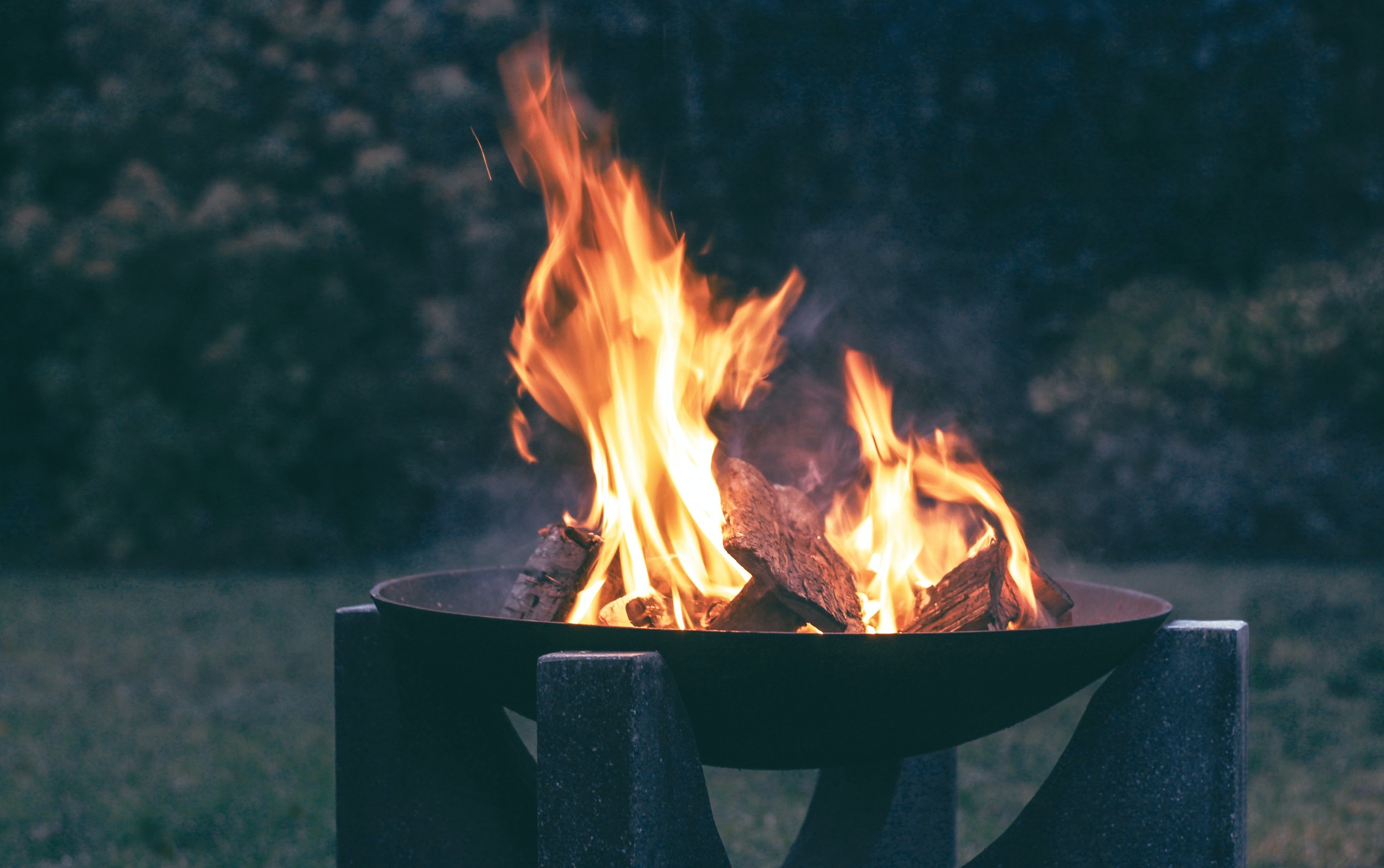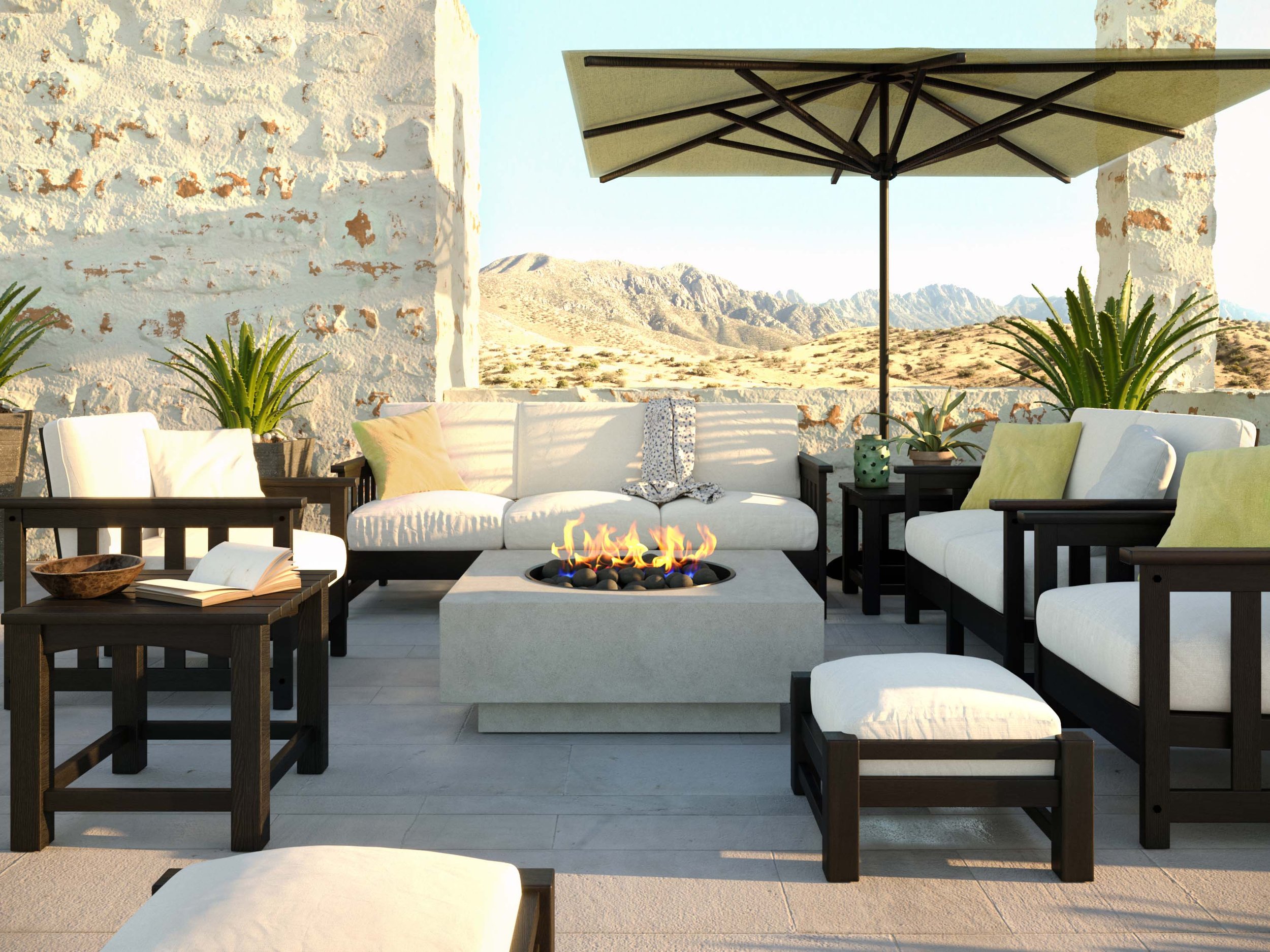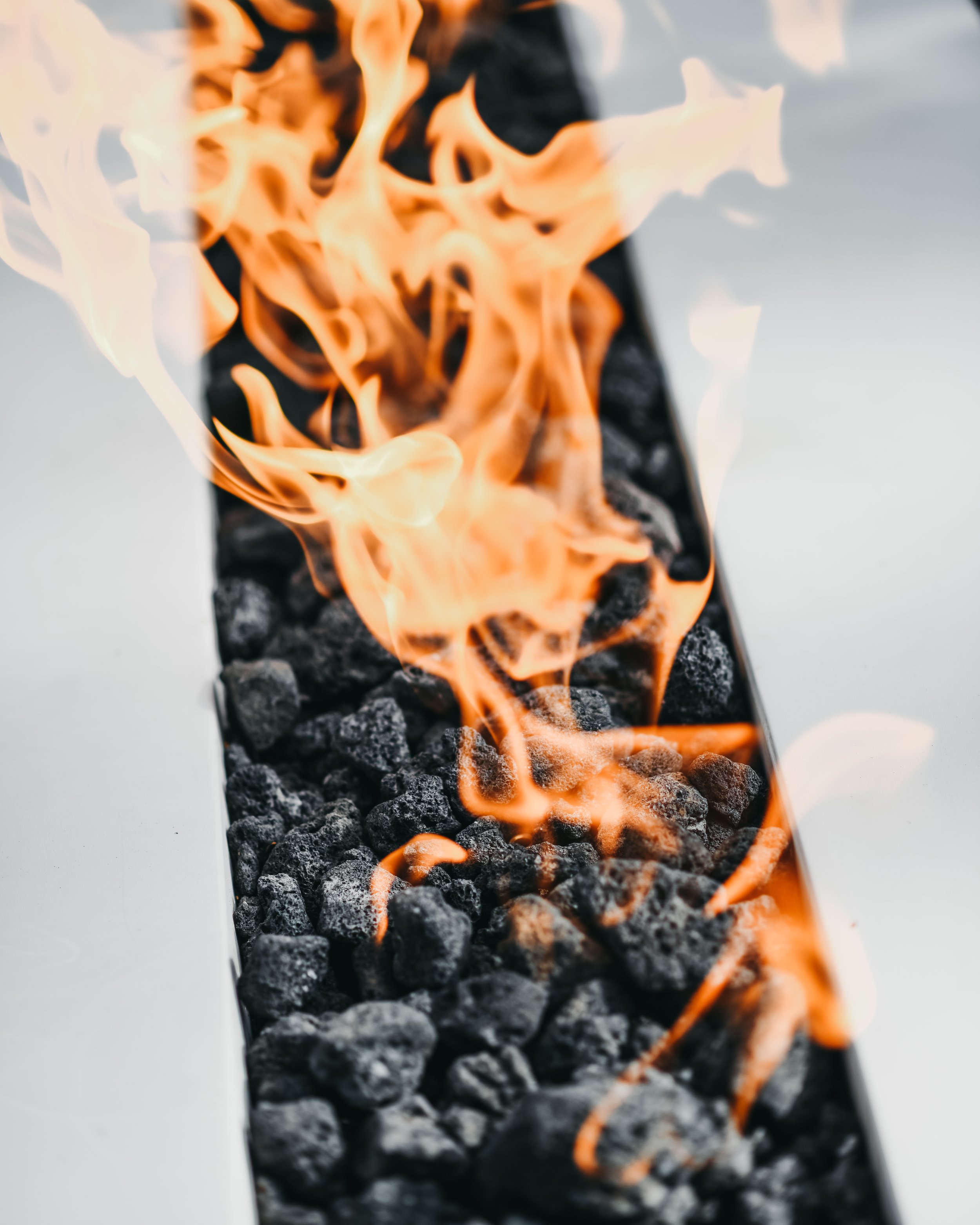Gas vs. Wood Fire Pits
The choice between gas and wood fire pits has become a hot topic, sparking contrasting preferences among homeowners and outdoor enthusiasts. While some prefer the convenience and modern aesthetics of gas fire pits, others find the nostalgic appeal of a wood fire pit hard to resist.
Whether you're seeking the ease of instant flames or longing for the authentic crackle of burning logs, both options come with distinct characteristics and experiences. This article is intended to explain these differences, talking about real-world experiences, concerns, and questions to guide you in making an informed choice. We'll cover all aspects to help you find the fire pit that best suits your lifestyle.
Fundamental Differences Between Gas and Wood Burning Fire Pits
There are several key differences between gas and wood fire pits. Understanding these can help you make a more informed decision on which type will be best for you.
Gas Fire Pits: Utilizing propane or natural gas as fuel, gas fire pits offer a controlled and efficient way to generate heat. Often praised for their modern look and clean burn, they provide instant warmth and the ability to precisely control the flame with a dial.
Wood Fire Pits: These traditional fire pits burn wood logs, offering a classic and authentic campfire experience. With variable heat and the unique charm of tending to the fire, wood pits bring a nostalgic feel but require more effort to manage.
Gas fire pits provide a convenient and modern solution with instant and adjustable heat, while wood fire pits offer a more authentic and engaging experience, with variable heat and a classic feel. Both options have their unique attributes and cater to different tastes and needs.
Pros and Cons of Gas Fire Pits
Gas fire pits have surged in popularity, offering a modern twist to the traditional art of gathering around a fire. Their ease of use and sleek designs make them a go-to choice for many.
Pros
Cleaner Burning: Gas fire pits burn cleanly, with no ash or sparks to worry about. This ensures you won’t have to worry about cleaning up after.
Instant Heat and Ease of Control: With the twist of a dial, you can have immediate heat and precisely control the flame's intensity. This convenience is perfect for those spontaneous evenings around the fire.
Modern Aesthetics: Often designed with contemporary spaces in mind, gas fire pits offer a sleek and stylish appearance.
No Smoke Smell After Use: Without the lingering odor of smoke, you can enjoy the fire without the need for a shower afterward.
Conforming to Local Regulations and Fire Bans: In many areas where wood burning is restricted, gas fire pits can be a legal backyard fire pit option.
Convenience for Frequent Use: If you use a fire pit regularly, the ease of turning it on and off can be a significant advantage.
Nobody Is Occupied with Tending the Fire: Everyone can enjoy their time, since there's no need to stoke the fire or manage logs.
Cons
Lack of Campfire Ambiance: For those who love the traditional fire experience, gas fire pits might feel lacking in character and ambiance.
Need to Refill Propane Tanks: Although convenient, you'll need to monitor your fuel and regularly refill propane tanks, which might be an inconvenience for some.
Some People Enjoy Stoking the Fire: If you find joy in tending to a fire, a gas fire pit won’t provide that same satisfaction.
Pros and Cons of Wood Burning Fire Pits
Wood burning fire pits have been a symbol of warmth and tradition. They evoke memories of campfires, storytelling, and a connection to nature.
Cons
More Time-Consuming to Start and Maintain: Unlike the instant on-off convenience of gas, wood fires require effort to start and keep going. You need to have dry wood on hand, split logs, and manage the fire carefully.
Ash Cleanup and Drainage Considerations: Post-use cleanup can be a chore, as you'll have to deal with ash disposal and ensure proper drainage.
May Cause Annoyance to Neighbors: In suburban areas, smoke from wood burning might be considered inconsiderate due to the smell and smoke.
Potential Health Issues from Smoke: The smoke from wood burning can be irritating to some, particularly those with respiratory conditions, and it can lead to a lingering smoke smell.
Open Fire Restrictions: Wood burning in open fire pits can be against various local laws and regulations due to the potential risks of fire hazards and air pollution.
Pros
Authentic, Nostalgic Experience: There's something undeniably classic about the crackle, smell, and warmth of a wood fire. It adds a rich, traditional touch to your outdoor space.
Sometimes Provides More Heat: When managed well, a wood fire can throw more heat, creating a cozy atmosphere on chilly nights.
Classic Aroma: The scent of burning wood is appealing to many and adds to the overall sensory experience.
Emphasizes the Ritual of Tending to the Fire: For those who enjoy the hands-on experience of building and maintaining a fire, wood fire pits offer a rewarding and engaging process.
Gas vs. Wood Fire Pit Costs
When choosing between gas and wood burning fire pits, understanding the costs involved in both initial investment and ongoing maintenance is important. Both options have unique financial considerations that can influence your decision.
Initial Investment
Gas Fire Pits: Often more expensive upfront, gas fire pits require specific components like gas lines or propane tanks. The modern designs and materials might also contribute to a higher initial cost.
Wood Burning Fire Pits: Typically, wood fire pits are less expensive to purchase or build. They can range from simple, rustic designs to more elaborate setups. Generally, they are more budget-friendly in comparison to gas fire pits.
Ongoing Maintenance
Gas Fire Pits
Fuel Costs: Refilling propane tanks or maintaining a natural gas line does involve recurring costs.
Low Maintenance: Aside from fuel costs, gas fire pits generally require less daily maintenance, potentially saving both time and money in the long run.
Wood Burning Fire Pits
Wood Storage and Purchase: The cost of buying, storing, and seasoning firewood can be a significant ongoing expense, depending on the frequency of use.
Ash Cleanup: Regular cleaning and potential drainage considerations might require additional tools or professional services, contributing to ongoing maintenance costs.
Potential Repair and Maintenance: Exposure to intense heat and elements may lead to more frequent wear and tear, adding to the long-term maintenance budget.
Installation, Maintenance, and Durability
The decision between gas and wood burning fire pits isn't solely about appearance, cost, or ambiance. It's also about the practical aspects of installation, ongoing maintenance, and the expected lifespan of the fire pit.
Installation
Gas Fire Pits
Professional Installation Recommended: Gas fire pits often require connecting to a natural gas line or setting up a propane tank, which may require professional installation.
Design Flexibility: Gas fire pits offer a wide variety of designs and can be integrated into different outdoor settings with a modern or traditional look.
Wood Burning Fire Pits
Simpler Installation: Typically, wood fire pits can be a DIY project or require minimal professional assistance, depending on the complexity of the design.
Considerations for Safety: Location and safety measures must be considered, such as distance from buildings and trees and proper ventilation.
Maintenance
Gas Fire Pits
Low Regular Maintenance: Gas fire pits usually require less daily upkeep, though periodic checks on gas lines or tanks are important.
Easy Cleaning: No ash or residue means cleaning is often as simple as wiping down surfaces.
Wood Burning Fire Pits
Regular Attention Needed: Managing firewood, dealing with ash, and ensuring proper drainage require regular attention.
Potential Repair and Maintenance: The intense heat and exposure to elements may call for more frequent maintenance or even part replacements.
Durability and Lifespan
Gas Fire Pits
Generally Longer Lifespan: Constructed with durable materials and having fewer exposure to intense flames, gas fire pits often last longer.
Potential Issues with Gas Components: Regular inspection of gas lines or tanks is important to avoid unexpected failures or safety concerns.
Wood Burning Fire Pits
Varied Lifespan: Lifespan can differ widely based on materials, construction quality, and how the fire pit is used and maintained.
Potential Wear and Tear: Regular exposure to intense wood flames may lead to faster wear and tear, affecting durability.
Safety and Health Concerns
When considering a fire pit, whether gas or wood burning, safety and health should definitely play a role in the decision-making process. Both types have unique concerns that should be considered.
Gas Fire Pits Safety and Health
Controlled Burning: Gas fire pits offer a controlled burn, reducing the risk of unexpected flare-ups or flying sparks.
Proper Installation: Ensuring professional installation and regular inspections can prevent gas leaks or other potential hazards.
Quickly Turned Off: In emergencies, gas fire pits can be quickly turned off, providing an additional safety layer.
Cleaner Burning: Burning gas typically produces fewer emissions and less smoke, reducing the risk of respiratory issues.
Wood Burning Fire Pits Safety and Health
Risk of Sparks and Embers: Wood burning can produce sparks or embers that may drift, which means the location of the fire pit becomes more important.
Supervision Required: Constant attention and care in tending to the fire are important to prevent accidental spreading.
Fire Extinguishing Tools: Having proper tools like a fire extinguisher or water source nearby is essential for quick response to any accidents.
Smoke Inhalation Risks: Exposure to wood smoke might lead to respiratory problems, particularly for those with asthma or other underlying health conditions.
Aesthetic Appeal, Atmosphere, and Customizations
The fire pit you choose will be a focal point of your outdoor living space, so its aesthetic appeal, the atmosphere it creates, and the customization options available will all influence your decision.
Gas Fire Pits
Modern and Sleek: Gas fire pits typically offer a more modern and sleek design, fitting well with contemporary outdoor decor.
Flame Control: The ability to control the flame height and intensity allows for a more tailored aesthetic experience.
Design Variability: Many gas fire pits come in various shapes, sizes, and materials, allowing for extensive personalization to match your outdoor space.
Wood Burning Fire Pits
Classic and Nostalgic: The traditional look and feel of a wood fire pit can provide a more rustic and nostalgic experience.
Natural Beauty: The glow of burning logs, the crackling sounds, and the dance of the flames create a mesmerizing visual spectacle.
Material and Design Choices: Like gas fire pits, wood fire pits come in various materials and designs, from simple to ornate.
Open Fire Regulations
Make sure you understand your local regulations for wood and gas fire pits for safe and legal operation.
Gas Fire Pits
Gas fire pits are generally subject to fewer regulations compared to wood burning but still require adherence to specific guidelines and codes. That might include proper installation of gas lines, use of certified equipment, safe distances from structures, and compliance with fire bans.
Wood Fire Pits
Wood burning in open fire pits can be against various local laws and regulations due to the potential risks of fire hazards and air pollution. Some areas may have restrictions on the type of wood burned, require permits for open burning, or even impose seasonal bans. Check with local authorities or fire departments to understand and comply with all relevant regulations.
Studio Nisho’s Gas Fire Pits
Rectangle Fire Pits
Our rectangle fire pits perfectly blend function and aesthetics, these outdoor features offer a modern touch to any outdoor setting.
Pallas: A statement piece of stone and flame, Pallas exudes passionate attention to detail. As day turns to night, it transforms into something much more. Light. Warmth. A setting for memories to be made. Pallas begs to be experienced first-hand, and what it gives back is unforgettable.
Atlas: Atlas makes no apologies in its mission to be bold. Precise edges and adventurous angles make this an exquisite statement piece for those who dare to be different. As night falls, Atlas’s warmth draws us in, transforming it into an undeniable centerpiece for a beautiful night.
Square Fire Pits
Our square fire pits are designed for both style and function. These outdoor essentials add a contemporary edge to any space.
Notus: Flames spark inspiration to gather. Notus compels us to draw close, with nurturing warmth and an open, inviting design. Here, everyone can have a spot next to the fire. A perfect accent or centerpiece, Notus strikes the ideal balance between luxury and accessibility.
Cronus: Classically inspired and masterfully executed, time slips away when basking in the warm glow of Cronus. This piece makes a masterful complement to any outdoor space, whether you’re playing host to large gatherings or simply enjoying a peaceful evening to yourself.
Chaos: Chaos proudly colors outside the lines to deliver simple elegance from unconventional style. It is at once both innovative and elemental, adding a dash of tasteful artistic flair to your outdoor gathering area and the perfect conversation starter for a lifetime of relaxing evenings.
Round Fire Pits
Carefully designed for aesthetic appeal and functionality, our round fire pits serve as an inviting focal point in any outdoor setting.
Kratos: Drawing inspiration from classical antiquity, Kratos appeals at once to our most sophisticated sensibilities and that within us which is most primal. Its cauldron shape has stood for competition, nourishment, enlightenment - now, reimagined with modern flair, it stands for a lifetime of memories ready to be made.
Nyx: Some pieces wait to be discovered. Nyx calls out from the dark of night with inviting warmth and chic style. Her delicate curves and offset flame quickly capture eyes and hearts, with an elegant aura that elevates recreational spaces into settings for unforgettable moments.
Hestia: A sanctuary from the modern world, Hestia transports us to a simpler time where the burning hearth was the center of the home. Blissfully reimagined with modern flair, this elegant, flowing piece provides the ideal centerpiece for your outdoor space.
Custom Fire Pits
We believe that your outdoor space should be an extension of your unique style and preferences. If you're looking through our collection and not finding exactly what you're looking for, contact us to hear about the custom fire pit options that are available.
Frequently Asked Questions
Can I use a gas fire pit during a local fire ban?
Generally, gas fire pits are allowed during local fire bans as they can be easily controlled and extinguished. However, it's always best to check with your local fire department or authorities for specific regulations in your area.
Can I customize the look of my gas fire pit?
Yes, many gas fire pits offer various customization options, including different shapes, sizes, and materials. We have a variety of styles that we offer, but if you’re looking for something custom, contact us and we can go over your options.
How much more work is involved in maintaining a wood burning fire pit compared to a gas one?
Wood burning fire pits generally require more effort in terms of starting the fire, maintaining it, and cleaning up ashes afterward. Gas fire pits offer a cleaner burn with minimal maintenance, usually just regular checks for leaks and occasional cleaning.
What is the cost difference between gas and wood fire pits?
Gas fire pits generally have a higher initial cost due to the need for a propane tank or natural gas line. Wood fire pits may be cheaper initially but will incur ongoing costs for firewood. Maintenance and operation costs should also be considered.
How does weather affect the operation of gas and wood fire pits?
Weather can affect both types, but gas fire pits may be more susceptible to wind, affecting the flame control. Wood fire pits may struggle in damp conditions if the wood is not properly stored. Proper covers and placement can mitigate these issues.
Conclusion
Choosing between a gas and wood-burning fire pit is a personal decision with a lot of factors to consider such as convenience, aesthetics, authenticity, and practical usage. Gas fire pits offer modern elegance and ease of use, while wood fire pits provide a nostalgic and engaging experience.
Your choice should align with your lifestyle, preferences, and the atmosphere you desire to create in your outdoor space. We hope this guide helps give you insights to make an informed choice that will create an outdoor experience that you can enjoy to the fullest.



















